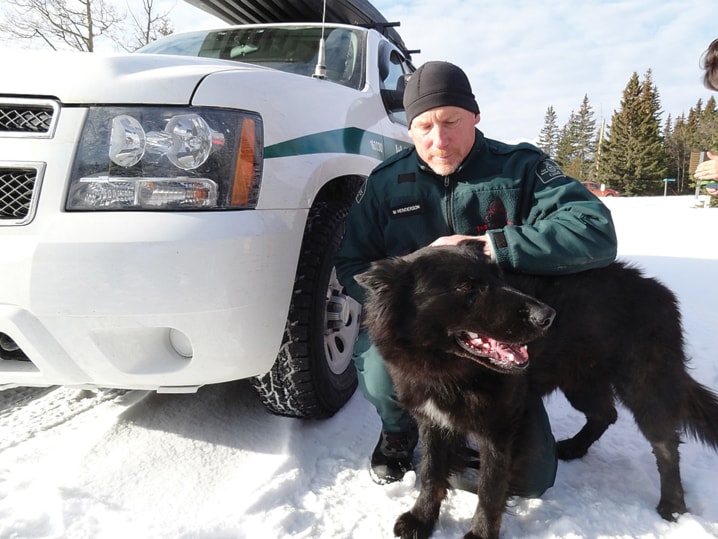“When I saw the dog’s teeth biting through the snow, I thought I might get bitten by mistake,” my companion said of her encounter with an avalanche rescue dog in training.
“I was buried in a snow cave and waited about 15 minutes for the dog to find me and dig me out. It was when he was digging that I saw the teeth!”
I marvelled at her ability to overcome the claustrophobia of being buried and the dog’s skills in finding her scent through centimetres of snow.
But avalanche rescue is not a new skill for dogs.
As early as the 1930s, dogs were trained by the Swiss Army to find avalanche victims. By searching for the airborne scent of a human body, dogs can find people buried under as much as 10 metres of snow.
Avalanche rescue dogs help at many Alberta mountain ski resorts and Parks Canada has one dog each in Jasper and Banff National Parks.
I was lucky recently to meet Cazz, Banff National Park’s newest avalanche rescue dog and his handler, Mike Henderson.
With his black coat and attentive gaze, at first glance Cazz looks like a wolf from a Robert Bateman painting, but he is a long-haired German shepherd and a graduate of the RCMP dog training facility near Innisfail.
After moving to Banff, Cazz started his avalanche training.
Mike explained how Cazz, in a departure from police dog training, must learn to be handled by other people without becoming aggressive (this is code for not biting the hand that is helping you).
“Sometimes I need to fly in a sling below the helicopter and someone in the aircraft has to be able to pick up Cazz and hand him to me without getting bitten,” Mike said.
The rigours of flying, running through deep snow, and porpoising around fallen trees means a service dog’s career is a relatively short five years.
But they accomplish a lot in five years, searching for drowning victims in the summer and avalanche victims in the winter.
Unfortunately, Cazz and other avalanche rescue dogs do not save as many lives as they would like.
Time is of the essence when a person is buried and it takes precious minutes for Mike and Cazz to reach an avalanche.
However, one handler and a trained dog can search the ground up to eight times as fast as 20 human searchers. If I were buried, I want Cazz looking for me.
Like any hard-worker, Cazz receives rewards, but they differ depending upon the work he is doing.
For following a scent trail to a target, Cazz gets to play with a favourite toy.
When he does his avalanche training, “he gets to destroy the fabric he finds,” Mike says with a smile.
Reminder to self: Do not wear clothes you do not want chewed by a rescue dog if you are entering avalanche country!
And that is just one thing to keep in mind if you are heading to the backcountry in winter.
Always check avalanche conditions beforehand, wear an avalanche transceiver, and carry gear for digging yourself or friends out.
You might not be lucky enough to have Cazz come to your rescue.
Carol Patterson of Kalahari Management Inc. has been speaking and writing about nature tourism and emerging destinations for two decades. When she isn’t travelling for work, she is travelling for fun.
More of Carol’s adventures can be found at www.kalahari-online.com.
